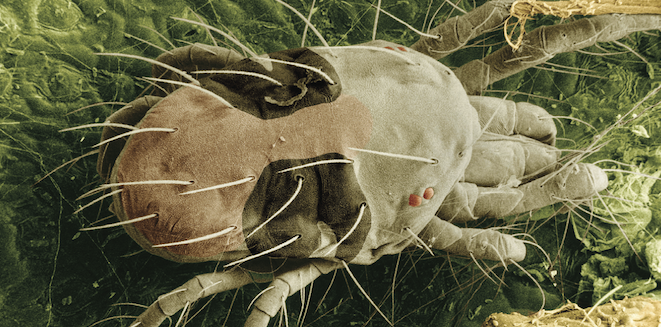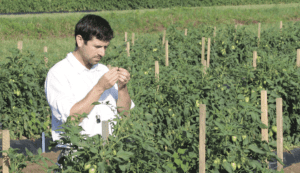

Dec 22, 2021Beneficials bring twospotted spider mite control on farms
The predatory mite Phytoseiulus persimilis can feast on twospotted spider mites and is widely released as a beneficial in greenhouses and some very high value field crops, like strawberries.
It can be effectively released into tomatoes grown in the field, but there are challenges.
P. persimilis must be introduced early. It must suppress twospotted spider mites before their population explodes.
However, P. persimilis is a specialized predator and feeds almost exclusively on twospotted spider mites. If P. persimilis is released too early, before spider mites are present, the predator will disperse out of the field in search of spider mites elsewhere.
“P. persimilis is a highly specialized feeder,” said Jim Walgenbach, professor and Extension entomology specialist for fruits and vegetables in North Carolina State University’s (NCSU) Department of Entomology and Plant Pathology.
“They move quite rapidly since they almost exclusively feed on twospotted spider mites,” Walgenbach said. “They’re going to go where the spider mite populations are the highest.” If that results in a rapid dispersal out
of the field, there probably won’t be enough P. persimilis left to suppress the spider mites in the tomatoes.
The NCSU release threshold for P. persimilis in field tomatoes is when scouting finds 0.5 spider mites per leaflet, which occurs shortly after spider mites are first detected in the field.
“In the absence of a control, mite populations can increase very rapidly so it’s important to put the predators out early,” Walgenbach said.
“As with most predator-prey dynamics, there is a lag time between the buildup of spider mites and P. persimilis, so ‘jump starting’ the P. persimilis population with releases helps to shorten that lag time,” said Tom Bilbo, postdoctoral research scholar in NCSU’s Department of Entomology and Plant Pathology.
Meticulous scouting urged
Scouting for twospotted spider mites is challenging because they are so small, but they do prefer to feed on the upper parts of the tomato plants. This means the most consistent result when scouting is to check the leaflet from the first or second fully expanded leaf on the top of the plant.
“We look at a leaflet on 10 plants, and we do that in about five to eight locations to get an idea on population density across the field,” Walgenbach said.
Keeping the cost down is another challenge when introducing P. persimilis into tomato fields. The typical release rate of about 20,000 P. persimilis per acre used in strawberries is simply not economically viable in tomatoes.
Rather than releasing in whole fields, NCSU researchers have had good results releasing at a rate of 20,000 beneficials per acre but only in a small portion of a field – maybe only a tenth of an acre, depending on field size.
“If we have a one-acre field and spider mites first infest the field along one margin, then we would release P. persimilus only in that margin,” Walgenbach said.
If that margin was a tenth of an acre, then only 2,000 beneficials would be released. The P. persimilus in this tenth of an acre will increase and then disperse and suppress spider mites throughout the entire field.
“You need a strategy that will take advantage of their rapid dispersal rate,” Walgenbach said. “Spider mites often enter the field at the same place every year. Focus the beneficial’s release in that area so they can quickly build up in numbers and disperse to other areas.”
Another sound strategy is to do a good job of sampling in the field and only release in those areas that have the highest numbers of spider mites. The beneficial’s population can then build with the spider mite population.


Release timing crucial
Planning a release strategy is complicated by field size because it’s easier for P. persimilis to leave small fields. The proximity of other twospotted spider mite hosts is also a complication.
“We know the beneficials will go to where the spider mites are,” Bilbo said. If those spider mites are in a nearby host crop, the P. persimilis may leave the tomato field to go after them.
However, the amount of spider mites in other crops is strongly affected by Neozygites floridana. This is a fungal pathogen of spider mites that devastates their numbers.
“In the humid weather of North Carolina, that pathogen really does a number on spider mites,” Walgenbach said. It’s the heavy use of fungicides on vegetable crops – and the fungicides’ effect on N. floridana – that contributes to spider mites being such a problem for vegetable growers.
There are good and bad times of the day to release P. persimilis. Early or late in the day is best when temperatures are more moderate. A release should not be made before any severe weather event.
“The most overriding factor in release success is insecticide use in the fields,” Walgenbach said.
Predator-safe products must be used.
“If you stay away from most of the pyrethroids, you’re probably OK,” Walgenbach said.
Pursuing a reliable method
There are clear advantages to managing twospotted spider mites with P. persimilis.
“Traditional, twospotted spider mite management has relied on miticides,” Walgenbach said, “but we find they give short control.”
“They knock down spider mite numbers for a week or two, but then they come right back,” Bilbo said.
“Especially during those hot times of the summer, miticides only provide temporary control,” Walgenbach said, “and mite populations will come back pretty quickly. P. persimilis is a more permanent control because it can drive the field population to extinction.”
In sustained, hot, dry weather, spider mites will build up rapidly and may require miticides be used in combination with predators.
“If the spider mite population increases too rapidly, we can use a predator-safe miticide to get the populations back into balance so the beneficial can have effective control,” Walgenbach said.
“It’s not uncommon to make two to three miticide applications in a year,” Walgenbach said. “If you can rely on one, that’s a cost advantage and a good resistance management tool.”
Both Walgenbach and Bilbo are based at NCSU’s Mountain Horticultural Crops Research and Extension Center at Mills River, North Carolina.
Much of the P. persimilis research at the center was funded by a recent Southern SARE (Sustainable Agriculture Research & Education) project.
— Dean Peterson, VGN correspondent














